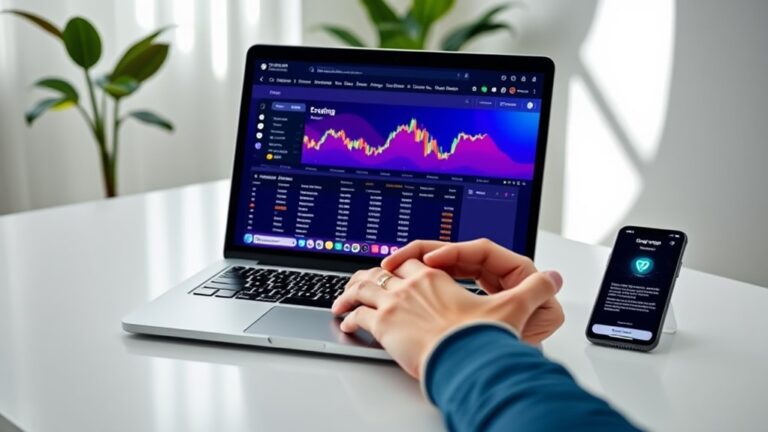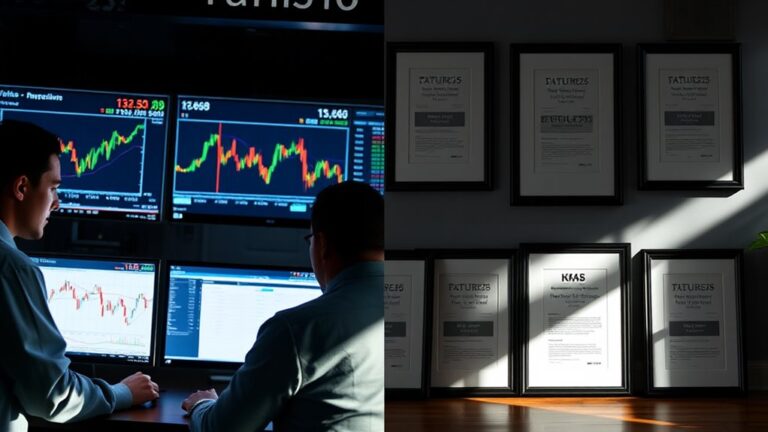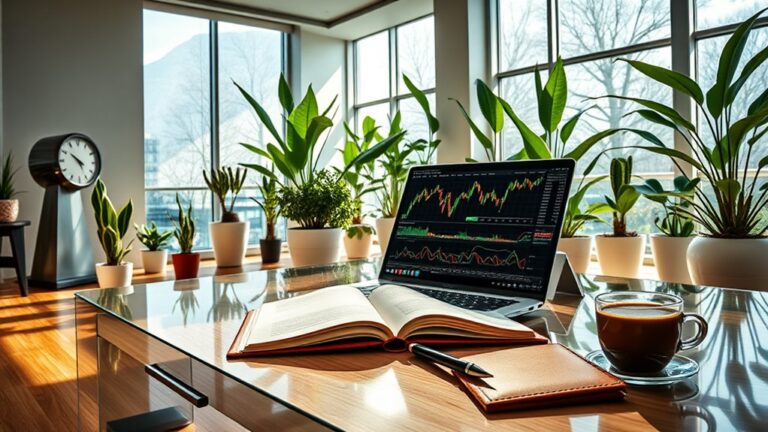
Market Order Vs Limit Order: Which Is Right for Your Trades?
Choosing between market orders and limit orders hinges on your specific trading needs and market conditions. Market orders guarantee rapid execution, making them suitable for trading highly liquid assets where quick action is valued. In contrast, limit orders offer control over trade prices and are preferred in volatile market environments or when exact entry and exit prices are essential. Both order types have their places, and further exploration can sharpen your trading strategies.
Key Takeaways
- Market orders ensure quick execution, ideal for stable, liquid markets with minimal price variations.
- Limit orders offer price control, suitable for volatile markets to manage risk through precise pricing.
- Evaluate urgency and desired speed of trade execution to choose between market and limit orders.
- Consider your risk tolerance: market orders for lower risk in price stability, limit orders for precise entry/exit in fluctuating prices.
- Market orders are simpler and often cheaper, while limit orders provide a strategic approach to maximize profits or minimize losses.
Understanding Market Orders: Speed and Simplicity in Trading

While market orders may not offer price control, they excel in providing speed and simplicity, key factors in certain trading scenarios.
Market orders are defined as directives to trade securities at the best available price immediately, making them ideal for highly liquid assets like large-cap stocks and exchange-traded funds (ETFs). This type of order guarantees expedient execution given adequate market liquidity and is especially beneficial during periods of low volatility when price fluctuations are minimal.
Market orders ensure quick execution with highly liquid assets, optimal in stable, low-volatility conditions.
Additionally, the straightforward nature of market orders makes them easy to place, often resulting in lower transaction fees. However, traders should be cautious of potential slips in prices during rapid market movements, which can lead to unexpected costs.
Market orders prioritize execution speed over price precision, suiting urgent trading needs effectively.
Exploring Limit Orders: Maximizing Control Over Trade Prices

In maneuvering the complexities of limit orders, traders often employ strategic price points to optimize their purchasing costs or selling gains.
However, one notable risk is partial fills, where not all the shares in an order may be bought or sold if insufficient volume exists at the desired price.
This mechanism provides a significant degree of control over transaction prices, but it does not guarantee complete order fulfillment, which can impact trading strategies.
Setting Strategic Price Points
Setting strategic price points through limit orders empowers traders to have significant control over the prices at which their trades are executed. Through limit orders, traders can harness multiple advantages by synchronizing entry and exit points with key market levels, often leveraging better pricing and market conditions. Particularly in volatile markets, confirming orders only execute at pre-established prices protects against unwanted slippage and aids in maintaining a disciplined trading strategy.
Understanding the varying types of trading strategies can significantly influence the decision on when and how to use limit orders effectively. This knowledge equips traders with the ability to optimize their market entry and exit points, aligning them perfectly with their strategic trading objectives.
| Aspect | Benefit | Strategy Impact |
|---|---|---|
| Price Control | Confirms execution at desired levels | Minimizes risks of unfavorable prices |
| Market Timing | Waits for ideal market conditions | Enhances potential profitability |
| Risk Management | Sets boundaries for potential loss | Controls adverse market impacts |
| Strategy Automation | Trades execute without continual monitoring | Simplifies operations |
Risk of Partial Fills
Exploring the nuances of limit orders, traders must consider the risk of partial fills, which represents a significant challenge in managing trade executions.
Here are four essential aspects to understand:
- Definition and Occurrence: Partial fills happen when a limit order only partially executes due to insufficient market liquidity, a common drawback in fast-moving or thinly traded markets.
- Handling Strategies: Traders may cancel the remaining unfilled portion, reassess, and possibly reenter under new conditions.
- Mitigation Approaches: Options like All or Nothing (AON) or Fill-or-Kill (FOK) orders help avoid partial fills by demanding complete execution.
- Impact: While potentially disruptive, partial fills can be part of strategic trade management in employing limit orders effectively.
Analyzing the Suitability of Market Orders for High-Liquidity Assets

Market orders, when applied to high-liquidity assets, have distinct advantages, particularly in minimizing the price impact even with sizable trades.
This suitability stems from the ready availability of buyers and sellers, which helps guarantee that orders are executed at or very near the current market prices.
An analysis of liquidity impact reveals that market orders efficiently facilitate transactions by leveraging the inherent stability and volume of liquid markets.
Benefits for Stable Assets
When trading stable, high-liquidity assets, investors find market orders particularly advantageous due to their immediate execution. These orders facilitate effective trading by prioritizing ease and temporal efficiency in various market conditions. The advantages can be specifically outlined as follows:
- Immediate Access: Investors gain instant entry into the market, capturing the best available prices without delay.
- Lower Slippage Risk: Due to the depth of the market, the risk of slippage is greatly reduced, making market orders a reliable choice.
- Predictable Prices: Stable price conditions in highly liquid markets assure that transactions reflect real-time market values.
- Simplicity and Speed: Especially beneficial for newcomers or those not seeking complex trade setups, market orders streamline the trading process, allowing for quick reactions to market changes.
Understanding the importance of risk management in trading is crucial, and using market orders when trading stable assets can significantly mitigate potential financial risks.
Liquidity Impact Analysis
The suitability of market orders in high-liquidity environments hinges notably on the seamless and swift execution they facilitate.
In markets flush with liquidity, these orders are often executed immediately, substantially minimizing the risks associated with slippage, even in fast-moving conditions. This promptness guarantees that trades are completed without considerable delay, aligning well with strategies that prioritize speed over exact pricing.
Furthermore, high liquidity generally coincides with narrow bid-ask spreads, which further diminishes the cost implications of potential price movements following order placement.
Consequently, when trading high-liquidity assets, market orders offer a strategic advantage by assuring high fill probability and execution certainty, essential in environments where market conditions can shift rapidly.
Incorporating the analysis of trading volumes can provide additional insight into the effectiveness of market orders in these liquid environments, as it reflects the overall market activity and the ease of executing large orders without affecting the asset's price too significantly.
The Strategic Use of Limit Orders in Setting Trade Boundaries

Utilizing limit orders effectively allows traders to set precise boundaries for their transactions, ensuring that they neither pay more than their maximum desired price when buying nor accept less than their minimum desired price when selling.
Here are several strategic approaches to using limit orders:
- Entry and Exit Strategy: Limit orders can be essential for implementing strategies that require entering or exiting at a specific price point, preventing emotional or impulsive decisions.
- Volatility Protection: In unstable markets, limit orders guard against sudden price swings, providing stability and predictability.
- Risk Control: By setting exact price barriers, traders can manage potential losses, aligning with their risk tolerance levels.
- Technical Utilization: Using technical analysis, limit orders are placed at strategic points driven by market data, enhancing the chances of favorable transactions.
Including technical analysis can be pivotal in identifying the most advantageous points for setting limit orders, considering historical price actions and market indicators.
Comparing Execution Risks: Immediate vs. Conditional Orders
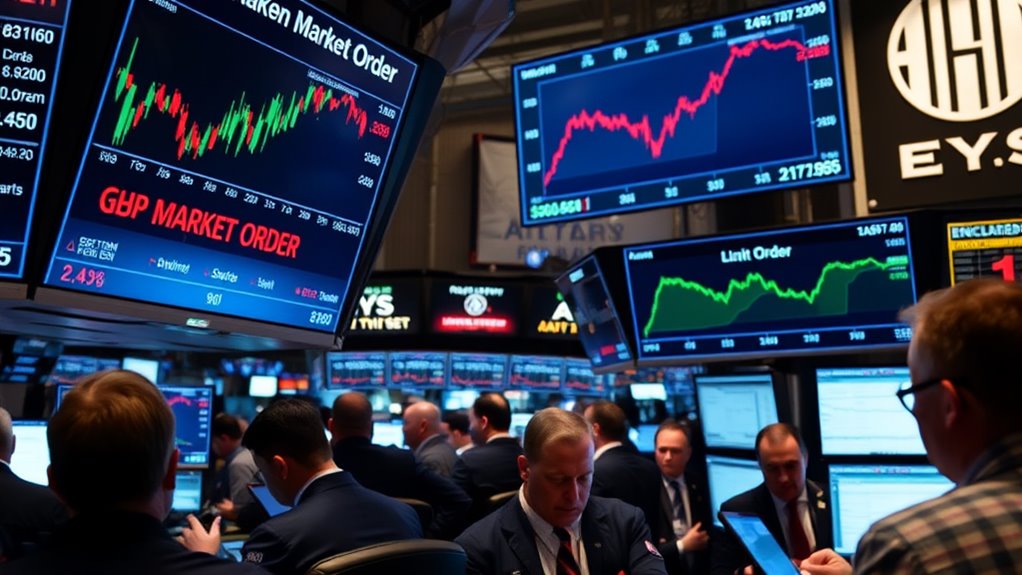
In trading, considering execution risks associated with different types of orders—immediate and conditional—is essential for informed decision-making.
Market orders offer surety of execution when there's sufficient liquidity, executing promptly, which is vital in volatile conditions albeit with risks such as slippage and possible unfavorable prices due to market movement or news.
Conversely, limit orders, while allowing precise price control and mitigating risks from price fluctuations, carry the risk of non-execution if the market never hits the specified price. They are also prone to partial fills in dynamic markets.
Additionally, maintaining and adjusting limit orders require more vigilance, ensuring traders stay responsive to shifting market conditions, which could extend the waiting period for potential trade executions.
The Role of Market and Limit Orders in Different Market Conditions
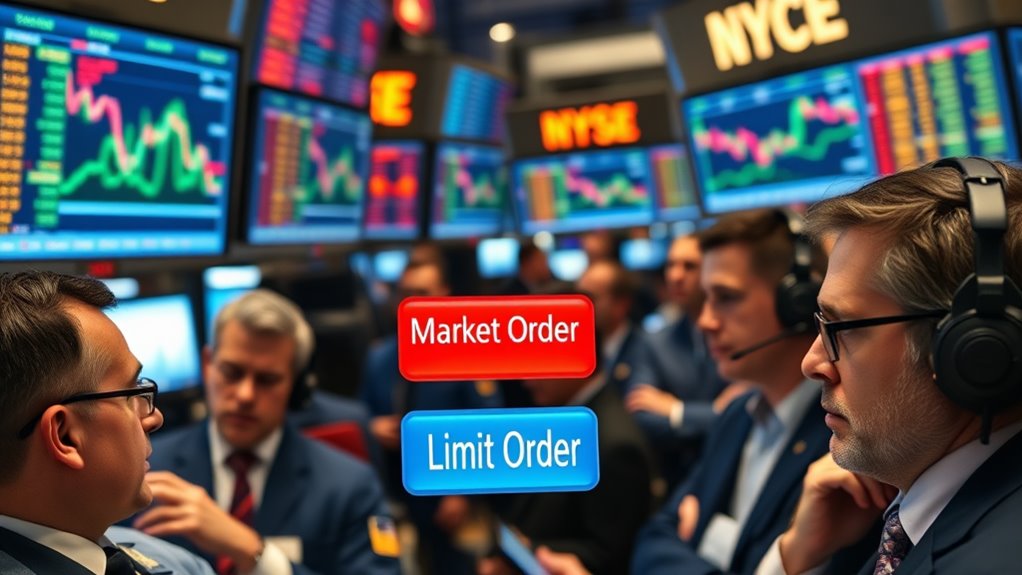
Given varying market conditions, the strategic selection between market and limit orders can markedly influence trading outcomes.
- Volatile Markets: Limit orders safeguard against drastic price swings, making them ideal during periods of high volatility, such as earnings announcements or global market turmoil, where market orders risk significant slippage.
- Stable Markets: In less turbulent environments, market orders facilitate prompt transaction completion at current prices, which are typically stable, minimizing the risk of losing a trading opportunity due to hesitation or price movement.
- Illiquid Stocks: For stocks with lower trading volumes, limit orders help maintain control over transaction prices, reducing the likelihood of extreme price variations resulting from large trades.
- Outside Standard Trading Hours: During pre-market or after-hours periods, when liquidity wanes and volatility spikes, limit orders are recommended to prevent adverse price movements.
How to Choose Between Market and Limit Orders for Optimal Trading Results

Why choose between a market order and a limit order when trading stocks? Choosing the right order type is vital for ideal trading results.
Market orders are best for times when speed is essential, ensuring immediate trade execution. They are particularly effective in stable, liquid markets where the price difference between sellers and buyers is minimal.
Market orders ensure quick execution, ideal in stable and liquid markets with minimal price differences.
Conversely, limit orders offer the advantage of price control and are preferable in volatile markets to avoid significant price fluctuations. These orders also allow strategic traders to set exact purchase or sale prices, though they run the risk of not executing if the market does not reach these prices.
Traders should consider their urgency, market conditions, and risk tolerance to select the most suitable order type.
Frequently Asked Questions
Can Market or Limit Orders Be Modified After Placement?
Both market and limit orders can be modified post-placement if they have not yet been executed. Traders access modification options through their trading platform, facilitating adjustments in price, quantity, or order type.
How Do Fees Differ Between Market and Limit Orders?
Fees for market orders are often lower due to faster execution, whereas limit orders can have higher fees for adding market liquidity but offer more precise pricing control, varying greatly between different trading platforms.
What Happens to Limit Orders That Don't Execute by Market Close?
What becomes of unexecuted limit orders at market close? Typically, if not specified as "Good till Canceled," these orders expire automatically at the end of the trading day, preventing unintended overnight financial exposure.
Are Market Orders or Limit Orders Better for Dividend Capture Strategies?
For dividend capture strategies, market orders guarantee immediate entry at prevailing prices, aiding swift dividend acquisition. However, limit orders offer price control and potentially better cost management but risk missing dividend opportunities if not executed.
How Do Market Makers Influence the Execution of Market vs. Limit Orders?
Market makers greatly impact both market and limit orders. They guarantee swift execution of market orders and strategically respond to limit orders, balancing market liquidity and minimizing price volatility. Their influence shapes trading dynamics effectively.
Conclusion
In the domain of trading, choosing between a market order and a limit order boils down to balancing immediacy against price control. Market orders offer swift execution, ideal for highly liquid assets where the price is stable. Limit orders, on the other hand, provide precision by setting price boundaries, suited for less volatile markets or specific trading strategies. Traders must weigh these factors carefully to align their order choice with their financial goals and market conditions for best trading outcomes.



